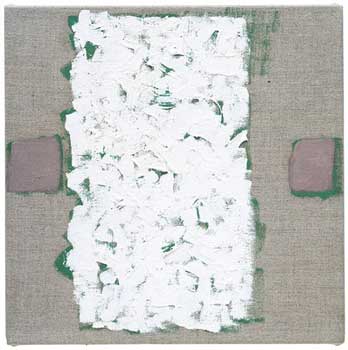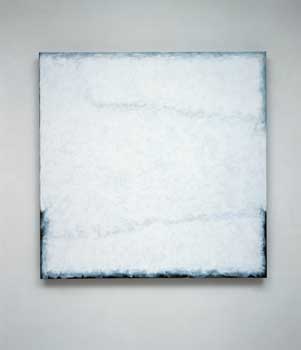
Robert Ryman was born in Nashville, Tennessee in 1930. Ryman studied at the Tennessee Polytechnic Institute and the George Peabody College for Teachers, Nashville, before serving in the United States Army (1950-52). Ryman’s work explodes the classical distinctions between art as object and art as surface, sculpture and painting, structure and ornament—emphasizing instead the role that perception and context play in creating an aesthetic experience. Ryman isolates the most basic of components—material, scale, and support—enforcing limitations that allow the viewer to focus on the physical presence of the work in space. Since the 1950s, Ryman has used primarily white paint on a square surface, whether canvas, paper, metal, plastic, or wood, while harnessing the nuanced effects of light and shadow to animate his work. In Ryman’s oeuvre, wall fasteners and tape serve both practical and aesthetic purposes. Neither abstract nor entirely monochromatic, Ryman’s paintings are paradoxically ‘realist’ in the artist’s own lexicon. Robert Ryman was elected to the American Academy of Arts and Letters (1994) and has received many awards, including a Skowhegan Medal (1985) and a fellowship from the John Simon Guggenheim Foundation (1974). He has had major exhibitions at the Tate Gallery, London (1993); Museum of Modern Art, New York (1993); San Francisco Museum of Modern Art (1994); Walker Art Center, Minneapolis (1994); Dia Art Foundation (1988); Inverleith House, Royal Botanic Garden, Edinburgh, Scotland (2006); and Pennsylvania Academy of the Fine Arts (2006-07). He has participated in Documenta (1972, 1977, 1982); the Venice Biennale (1976, 1978, 1980); the Whitney Biennial (1977, 1987, 1995); and the Carnegie International (1985, 1988). Ryman lives and works in New York and Pennsylvania.

About his work, Ryman says,
“I don’t think of my painting as abstract because I don’t abstract from anything. It’s involved with real visual aspects of what you are looking at‚Äîwhether wood, paint, or metal‚Äîhow it’s put together, how it looks on the wall and works with the light…Of course, realism can be confused with representation. And abstract painting‚Äîif not abstracting from representation‚Äîis involved mostly with symbolism. It is about something we know, or about some symbolic situation…I am involved with real space, the room itself, real light, and real surface.”
(taken from the companion book Art in the Twenty-First Century 4, p. 142).
Read more about his work and watch clips on his Art:21 webpage here.
Have you experienced Ryman’s work in person, or did you have an opportunity to view his segment in one of the hundreds of Art21 Access ‘07 events that have been taking place all month? Share your thoughts on Robert Ryman by leaving a comment below.



